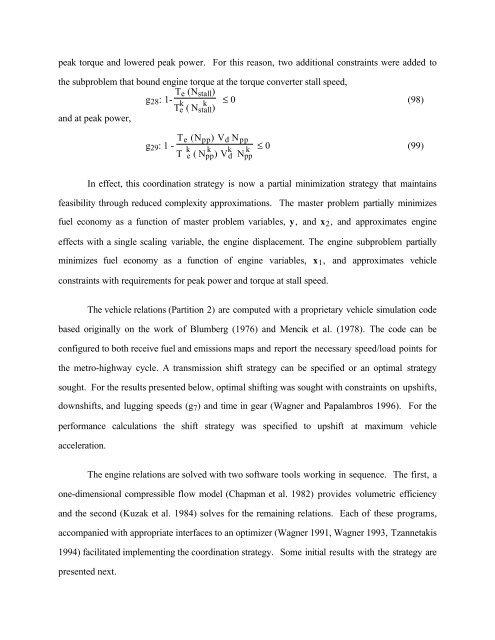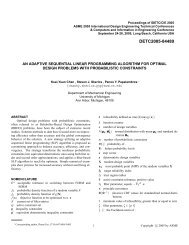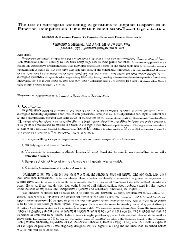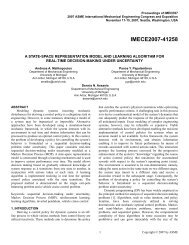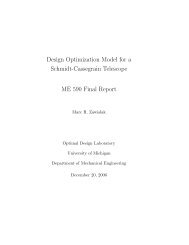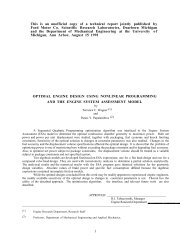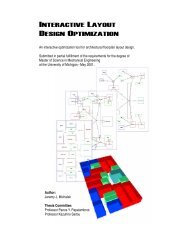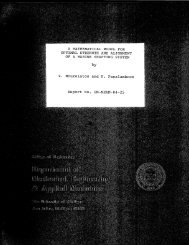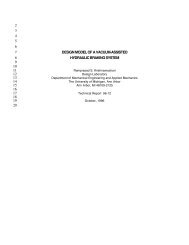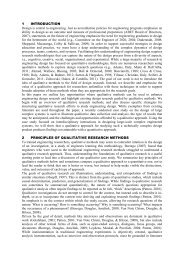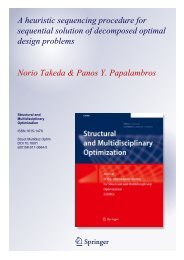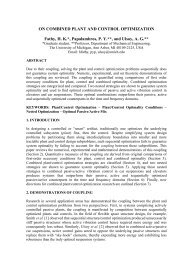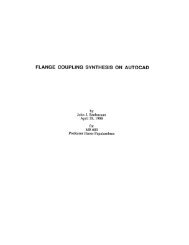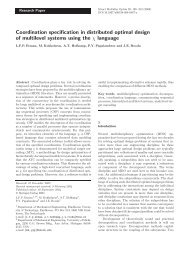Decomposition Analysis of an Automotive Powertrain Design ...
Decomposition Analysis of an Automotive Powertrain Design ...
Decomposition Analysis of an Automotive Powertrain Design ...
You also want an ePaper? Increase the reach of your titles
YUMPU automatically turns print PDFs into web optimized ePapers that Google loves.
peak torque <strong>an</strong>d lowered peak power. For this reason, two additional constraints were added to<br />
the subproblem that bound engine torque at the torque converter stall speed,<br />
g 28 : 1- T e (N stall )<br />
Te k (Nstall)<br />
k ≤ 0 (98)<br />
<strong>an</strong>d at peak power,<br />
g 29 : 1 - T e (N pp ) V d N pp<br />
T k e (N k pp) V k d N k pp<br />
≤ 0 (99)<br />
In effect, this coordination strategy is now a partial minimization strategy that maintains<br />
feasibility through reduced complexity approximations. The master problem partially minimizes<br />
fuel economy as a function <strong>of</strong> master problem variables, y, <strong>an</strong>d x 2 , <strong>an</strong>d approximates engine<br />
effects with a single scaling variable, the engine displacement. The engine subproblem partially<br />
minimizes fuel economy as a function <strong>of</strong> engine variables, x 1 , <strong>an</strong>d approximates vehicle<br />
constraints with requirements for peak power <strong>an</strong>d torque at stall speed.<br />
The vehicle relations (Partition 2) are computed with a proprietary vehicle simulation code<br />
based originally on the work <strong>of</strong> Blumberg (1976) <strong>an</strong>d Mencik et al. (1978). The code c<strong>an</strong> be<br />
configured to both receive fuel <strong>an</strong>d emissions maps <strong>an</strong>d report the necessary speed/load points for<br />
the metro-highway cycle. A tr<strong>an</strong>smission shift strategy c<strong>an</strong> be specified or <strong>an</strong> optimal strategy<br />
sought. For the results presented below, optimal shifting was sought with constraints on upshifts,<br />
downshifts, <strong>an</strong>d lugging speeds (g 7 ) <strong>an</strong>d time in gear (Wagner <strong>an</strong>d Papalambros 1996). For the<br />
perform<strong>an</strong>ce calculations the shift strategy was specified to upshift at maximum vehicle<br />
acceleration.<br />
The engine relations are solved with two s<strong>of</strong>tware tools working in sequence. The first, a<br />
one-dimensional compressible flow model (Chapm<strong>an</strong> et al. 1982) provides volumetric efficiency<br />
<strong>an</strong>d the second (Kuzak et al. 1984) solves for the remaining relations. Each <strong>of</strong> these programs,<br />
accomp<strong>an</strong>ied with appropriate interfaces to <strong>an</strong> optimizer (Wagner 1991, Wagner 1993, Tz<strong>an</strong>netakis<br />
1994) facilitated implementing the coordination strategy. Some initial results with the strategy are<br />
presented next.


